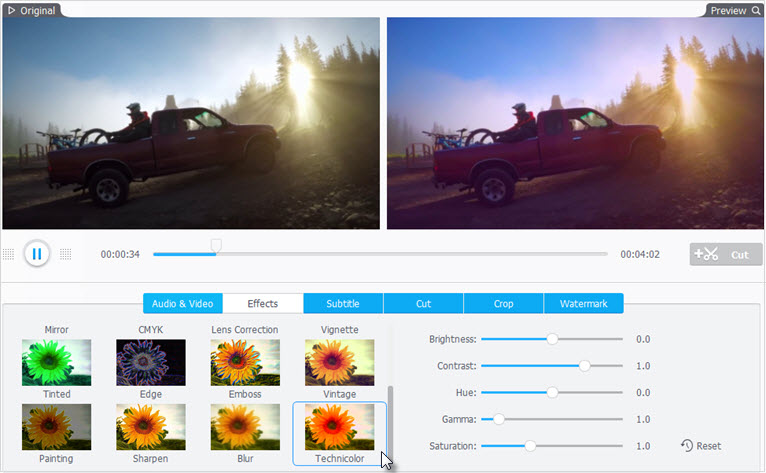Why does iMovie Reduce Quality
Multifold factors contribute to the problem of iMovie exported video quality loss. It's unlikely to list them all out. Instead, we pick up the major reasons and corresponding workarounds to help you out of this iMovie quality loss trouble.
Major Reasons:
1. iMovie would use Apple Intermediate Codec (AIC) to compress and convert your inputs into a format (.mov) even though you just do the conventional video editing stuff and don't manually enable any video codec conversion. This would lead to quality drop in certain degree.
2. Some users opt for Share > Publish to iTunes as exporting option. They get the poor video quality when playing back no matter which size settings they choose, Mobile, Medium, Large, HD 720p and HD 1080p. In such case, the exporting option you select might be the one to be blamed.
3. When it comes to upload video to YouTube within iMovie, the video quality is terrible. Beyond iMovie auto lossy compression, YouTube is also responsible for the quality decrease. It sets the compression levels and further converts your video to flash video format during video uploading.
4. If you upgrade to macOS Sierra or a later version and find the iMovie output video gets blurry in image quality, both iMovie version and macOS operating system are linked to this error. Because iMovie 9 can't be fully compatible with macOS that is higher than Mac OS X Yosemite.
5. The created iMovie project sounds great but the audio quality sucks after export/share. The problem ought to be in the audio waveforms in the audio track.
How to Fix iMovie Quality Loss After Exported
1. Load video source with higher quality like 8K, 4K, 2.5K, 2K, 1080p. Thus, the slight video loss would be invisible if you're an iMovie loyal fan.
2. You'd better choose Share > Export Using Quicktime instead of iTunes as output option with as bigger size as possible (higher quality, bigger size).
3. After video editing is finished with iMovie, export and save it to your computer. Then open Safari to upload video to YouTube from your Mac. This way is tested to be effective in video quality improvement.
4. Upgrade your iMovie to the latest version to best suit your macOS.
5. Check your audio levels. If there is a yellow or red line running through the waveforms, reduce the audio track volume roughly 15%.
6. Resort to iMovie alternative like VideoProc Converter AI, which would do more things than iMovie and more importantly it doesn't do any harm to your video quality. With this video editor in hand, you can cut, trim, crop, split, merge, rotate, flip & mirror a video, add watermark, add subtitle, denoise, stabilize shaky video, correct fisheye distortion, brighten video, speed up (16x)/slow down (10x), fix A/V out of sync, upscale video resolution, adjust frame rate/bit rate, change aspect ratio and more.
Note: The Windows version now supports AI-powered Super Resolution, Frame Interpolation, and Stabilization to enhance video and image quality. These AI features are not yet available in the Mac version but will be coming soon.
If the iMovie export file still disappoints you with poor quality after you have adjusted export settings or updated iMovie version, you can consider to have a try on the top iMovie alternative - VideoProc Converter AI. Unlike iMovie with auto AIC conversion, this toolbox enables you to edit video including cut, trim, crop, split, merge, rotate, add watermark/subtitle, add special effects (sharpen/Vintage/Vignette...), speed up (16x)/slow down (10x), fix A/V out of sync, audio delay without having to re-encode your video source. Therefore, you can simply edit iPhone video, GoPro video, Drone footages and more without quality loss.
That's not the whole story. On top of lossless video editing, it can further enhance your original video quality to an even higher level. Let you adjust brightness, hue, contrast, saturation to improve image quality, stabilize your shaky video, remove background noise from video to improve audio quality, correct fisheye distortion to produce normal visual effects, as well as upscale resolution (1080p to 4K), improve frame rate/bit rate, change aspect ratio for better quality.
How to Edit Video without Quality Loss
Step 1: Load Video Footage
Free download VideoProc Converter AI on your macOS or Windows. Run it on your desktop after the installation is done. Click Video on the home screen > hit "+Video" button to import your video source. Bulk conversion is supported via multiple loading or "Video Folder".
Step 2: Apply Filters & Adjust Brightness
Tap "Effect" at the video info bar after the video inputs are successfully analyzed. You can choose "Sharpen", "Emboss", "Vintage", "Painting".... under Effects. What's more, feel free to move the slide bar to brighten video via brightness, contrast, adjust gamma and saturation to improve your video quality.
There are more video editing features available, be it Audio & Video (speed up/slow down, Force A/V sync, audio delay, audio volume incl.), subtitle, cut, crop, watermark. Just tick them to apply them into your video. There is no need to illustrate them in detail one by one, cuz the self-explanatory interface has already guided you.
Step 3: Deshake, Denoise & Correct Fisheye
Put your mouse to the bottom of the home screen > click and enter "Toolbox".
* Click "Deshake" to fix shakiness issue in video recorded by GoPro/action cams.
* Activate "Denoise" to eliminate video noise to improve audio quality.
* Select "Fisheye" to help you solve video fisheye distortion issue.
Step 4: Upscale Resolution, Frame rate...
Press "Codec Option" icon and you're directed to a new window, where you can freely opt for the resolution (8K, 5K, 4K 2160p, 2.5K, 2K, 1080p, 720p...), frame rate (240FPS, 120FPS, 60FPS, 30FPS...), bit rate (ABR/CBR), aspect ratio and audio codec options at your disposal. Thus, you can be liberated from the maddening iMovie problem (limited resolution and settings options) and preserve video quality as high as possible.
Step 5: Process Video Now
When everything is ready, give the final hit on "RUN" button. Then VideoProc Converter AI's processing engine will go into action to process and edit your video files at GPU hardware accelerated speed if your computer supports hardware acceleration like Intel QSV, Nvidia, AMD.
Warm Prompt: you're warmly welcomed to share with us about other awesome video editors like iMovie via Email if you have been impressed by them.
![]() Summary: Here you will find 5 reasons why iMovie blurry when exported, and corresponding solutions to fix iMovie quality loss. For causes that are iMovie-innate, you can resort to the video quality enhancer: VideoProc Converter AI to edit and process video without quality loss.
Summary: Here you will find 5 reasons why iMovie blurry when exported, and corresponding solutions to fix iMovie quality loss. For causes that are iMovie-innate, you can resort to the video quality enhancer: VideoProc Converter AI to edit and process video without quality loss.







 Home
Home
